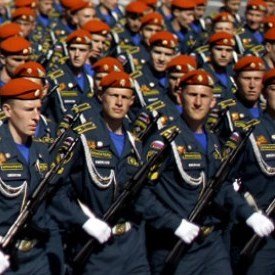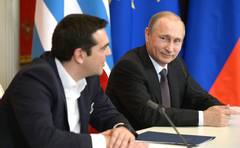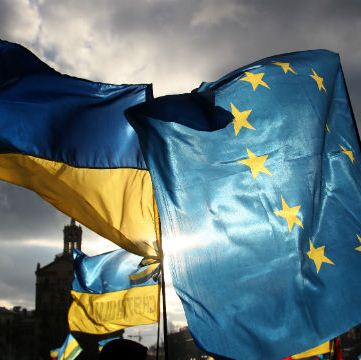This is an Oxford Analytica brief that was originally published on April 14, 2015. I've restored a few cuts made for space reasons.
SIGNIFICANCE: Russia's military is currently undergoing a 700 billion dollar rearmament programme, with Moscow aiming to supply the military with 70% modern equipment by 2020. The reform plan is looking to upgrade Russia's armoured formations with a new family of vehicles collectively called Armata. The Armata tank variant will be far superior to any tank operating in Russia's neighbours as well as many NATO armies. However, it is costly and the Defence Ministry is actively trying to force down the price.
ANALYSIS: Impacts
- Defence spending has been largely protected from 10% spending cuts but budgetary pressures will remain.
- It will take time to bring defence and procurement spending in many NATO members up from current low levels below 2% of GDP.
- The Ukraine crisis will force Russia's defence industry to produce weaponry domestically with less reliance on foreign supplies.
Russia has about 16,000 tanks in its inventory, including 4,000 T-64, 8,000 T-72 and T-90 variants, and more than 4,000 T-80s. Of these, only about 2,400 are in service; the rest are in storage. All T-64 tanks are in storage, although some may have been provided to separatist forces fighting in Ukraine. About 1,000 T-80 tanks were in service in 2013, though all are to be withdrawn from service by end-2015.
The majority of the in-service tanks are of the T-72 and T-90 variants, including 564 modernised T-72B3 tanks (according to Defence Minister Sergei Shoigu), and 300 T-90 tanks. The modernised T-72B3 tanks are gradually replacing the other varieties, at a rate of 300 tanks per year.
Tank standardisation
The goal is to unify the types of tanks as much as possible in order to reduce maintenance costs. The modernisation of T-72 tanks costs 50 million rubles (962,000 dollars) each. These new T-72s have a new engine, new control and targeting systems, new armaments, and new active and passive defence systems.
These improvements have made the modernised T-72 less vulnerable to enemy ordnance and improved firing accuracy. However, active defence systems and electronics are still outdated by comparison with the competition.
Armata platform
The Armata is a universal tracked-vehicle platform designed to serve as the basis for a new Russian main battle tank (MBT), a related heavy infantry-fighting vehicle, a combat-engineering vehicle, a heavy armoured personnel-carrier, a tank-support combat vehicle and several types of self-propelled artillery.
Armata tank capabilities
The main armament will consist of a 125-millimetre (mm) smoothbore cannon with 40-48 rounds of ammunition, with an additional 30-mm secondary cannon and a 7.62-mm machine-gun. The main cannon is reported to have a range of 7,000-8,000 metres and the engine has been variously rated at between 1,200 and 2,000 horsepower, with a corresponding top speed in either the 70-75 kilometres per hour (kph) or 80-90 kph range.
The tank is designed so that the engine can be removed in 30-40 minutes in the event of a malfunction. The tank will have a crew of three, but unlike other tanks now deployed the Armata will have an unmanned turret operated by remote control.
Radar system
The tank will be equipped with a Ka-band active phased-array radar system similar to that being developed for the Sukhoi T-50 fifth-generation fighter aircraft. The targeting system is capable of tracking up to 40 targets.
Crew survivability
Crew survivability appears to be a priority in the design. In addition to the advantages offered by the unmanned turret, the Armata will use a new type of light-weight armour, developed specifically for the tank by the Steel Scientific Research Institute. The armour will reportedly be able to withstand fire from most types of artillery. Furthermore, the armour is said to be able to maintain its defensive qualities in extremely low temperatures, making the tank potentially useful in the Arctic.
In addition, the Armata is to be equipped with active anti-missile and anti-artillery defenses that will protect the tank from both ground-based and aerial attacks. The ammunition, fuel, and crew are to be separated in order to increase survivability in the event of a successful enemy hit.
Comparison with competition
By comparison with previous Russian tank models, it has a revamped engine, new transmission and improved chassis strength. The Russian media have said that technically it will be four times as capable as the late Soviet T-72B MBT. They also argue that the tank's capabilities will be superior to those of its main foreign competitors. Its armament and horsepower appear to be comparable to the US Abrams, German Leopard and Israeli Merkava tanks, while the UK Challenger has a less powerful engine.
The Armata's armour will probably be thinner than that of the Challenger or Merkava, but thicker than that of the Abrams and Leopard. However, if reports about advances in armour design prove true, it may be that the thinner armour provides comparable or superior protection. Finally, the tank will most probably be lighter than its competitors, all of which weigh in at 62-70 tonnes.
Procurement plans
The State Armament Programme calls for the procurement of 2,300 new MBTs by 2020. While some reports have linked this figure with the number of Armata tanks to be procured, the reality is that the Armata is going to enter the Russian military in much smaller numbers, owing to both production limits and high unit cost.
An initial batch of 20-24 tanks is expected to be provided to the military in time for theMay 9 Victory Day parade in Moscow. After the parade, these tanks will be sent for field testing, which is expected to take at least a year. The testing programme could take up to three years and full serial production may not start until 2018.
Uralvagonzavod, its manufacturer, has stated that it is ready to produce 40 tanks in 2016, 70 in 2017 and up to 120 per year from 2018. So the absolute maximum number of Armata tanks potentially in service by 2020 is about 330.
High costs could impose limits
However, the high cost of the Armata tank is expected to limit procurement. According to unofficial sources, the cost per tank is approximately 400 million rubles, which is more than double that of the German Leopard-2 and about 60-75% higher than that of the French Leclerc and US M-1 Abrams. Yuri Borisov, the deputy defence minister responsible for procurement, has indicated that the cost is about 2.5 times higher than stated in the State Armaments Programme.
As a result, the Defence Ministry is expecting to reduce the number of Armata tanks it will procure, focusing instead on continuing to modernise existing T-72 tanks in the medium term. According to Russian media reports, Uralvagonzavod has agreed to lower someArmata costs, but the programme will still be expensive.
CONCLUSION: The Armata tank promises to be a formidable but expensive machine, limiting its procurement in the short term. Given Russia's economic problems, it is unlikely to become the ground forces' sole tank. The Russian military will continue to deploy upgraded T-72B3 tanks in most armoured units, while Armatas will be reserved for elite units. The first serious unveiling of the Armata tank will be at the Moscow Victory Day parade on May 9.
– – – – – – – – – – – –
See the original post at Russian Military Reform.











